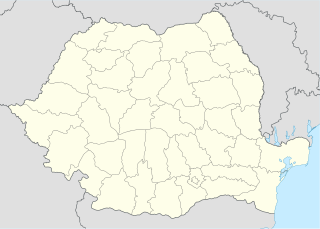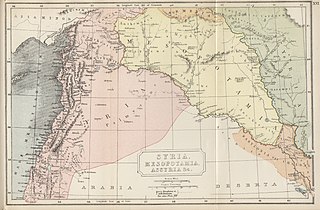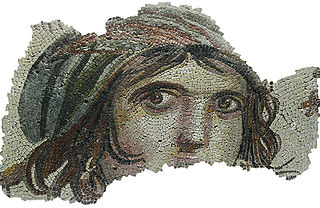Seleucia was the first capital of the Seleucid Empire and one of the great cities of antiquity but is now an abandoned ruin.
Dacian, Geto-Dacian, Daco-Getic or Daco-Getian often refers to something of or relating to:

Zeugma is an ancient Greek city of Commagene; located in modern Gaziantep Province, Turkey. It was named for the bridge of boats, or zeugma, that crossed the Euphrates river at that location. Zeugma Mosaic Museum contains mosaics from the site, and is one of the largest mosaic museums in the world.

Samsat is a small town and district in the Adıyaman Province of Turkey, situated on the upper Euphrates river. The town is populated by Kurds.

Romula or Malva was an ancient city in Roman Dacia, later the village of Reşca, Dobrosloveni Commune, Olt County, Romania. It was the capital of Dacia Malvensis, one of the three subdivisions of the province of Dacia.

Birecik, also formerly known as Bir, Biré, Biradjik and during the Crusades as Bile, is a town and district of Şanlıurfa Province of Turkey, on the River Euphrates.
Seleucia at the Zeugma was a Hellenistic city or fortified town in the present Republic of Turkey, on the left, or south, bank of the Euphrates, across from ancient Samosata and not far from it.

Apamea or Apameia was a Hellenistic city on the left bank of the Euphrates, opposite the famous city of Zeugma, at the end of a bridge of boats connecting the two, founded by Seleucus I Nicator. The city was rebuilt by Seleucus I. The site, once partially covered by the village of Tilmusa, Şanlıurfa Province, Turkey, is now flooded by the lake formed by the Birecik Dam.

The Kingdom of Commagene was an ancient Greco-Iranian kingdom ruled by a Hellenized branch of the Iranian Orontid dynasty. The kingdom was located in and around the ancient city of Samosata, which served as its capital. The Iron Age name of Samosata, Kummuh, probably gives its name to Commagene.

Cyrrhestica is a district of Greater Syria which appears to have owed its name to the Macedonian occupation of the country. It lies to the east of the plain of Antioch and Amanus, and was bounded on the east by the Euphrates and Commagene to the north, it extended as far as the desert. This fertile, well-watered, and thickly peopled district occupied the right bank of the Euphrates, where the river inclines rather eastward of south. It was the scene of the campaign in which Ventidius defeated the Parthian Pacorus and avenged Crassus and the Roman army which had fallen at Carrhae. Constantine I united it with Commagene under the name of Provincia Euphratensis. The chief towns of Cyrrhestica were Hierapolis Bambyce, Zeugma, Europus, Birtha?, Beroea, Batnae, and Cyrrhus.

Mithridates II Antiochus Epiphanes Philorhomaeus Philhellen Monocrites, also known as Mithridates II of Commagene, was a man of Iranian and Greek descent who lived in the 1st century BC. He was a prince of Commagene and one of the sons of King Antiochus I Theos of Commagene and Queen Isias Philostorgos of Commagene. When his father died in c. 31 BC, he succeeded his father and reigned until his death.

The Gaziantep Museum of Archaeology is an archaeological museum located in the city of Gaziantep, Turkey. It housed for some years a collection of mosaics, most of which were excavated from the ancient Roman city site of Zeugma. A new museum, the Zeugma Mosaic Museum now houses those. After an overhaul of the displays the museum now houses a fine collection of finds from the region, well-organized and explained. Exhibits include a collection of paleolithic artifacts; items from a Bronze Age necropolis; Hittite, Persian, Roman, Hellenistic, and Commagene artworks and glassware; Ottoman and Islamic coins and medallions; and the skeleton of a mammoth. Attached to the museum is a garden containing a selection of stone artifacts, including pagan tombstones from Zeugma, Christian tombstones, and Hittite statuary.

Aedava was a Dacian settlement located south of the Danube in Moesia. In his De Aedificiis, the 6th century AD historian Procopius placed Aedava on the Danubian road between Augustae and Variana. He also mentioned that Emperor Justinian restored the damaged portion of the town defenses.

Sucidava was an ancient settlement on the Danube, between Durostorum and Axiopolis, most probably located near the modern village of Izvoarele, in Romania. Not to be confused with the Sucidava near Oescus.
Zeugma was a Dacian town mentioned by Ptolemy.

Tibiscum was a Dacian town mentioned by Ptolemy, later a Roman castra and municipium. The ruins of the ancient settlement are located in Jupa, Caraş-Severin County, Romania.

Dülük is a village in Şehitkamil district, a district of Greater Gaziantep, Turkey. At 37°09′N37°22′E, it is about 10 kilometres (6.2 mi) from Gaziantep city center. The population of Dülük was 2,256 as of 2012. As ancient Doliche, a former bishopric, it remains a Latin Catholic titular see.

Euphratensis, fully Augusta Euphratensis, was a late Roman and then Byzantine province in Syrian region, part of the Byzantine Diocese of the East.
Gaziantep Arena is a stadium in Gaziantep, Turkey. It has a capacity of 35,574 spectators. and was opened on 15 January 2017. It is the home ground of Gaziantepspor, replacing Gaziantep Kamil Ocak Stadium. Its distance to city centre is only 10 kilometers. For it to reflect the tradition of the city of Zeugma, Commagene, outside walls of the stadium are covered with mosaic.










